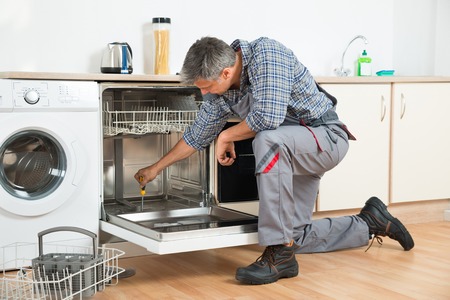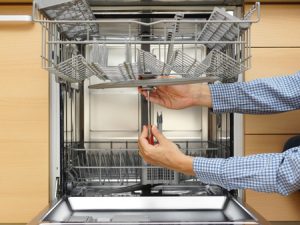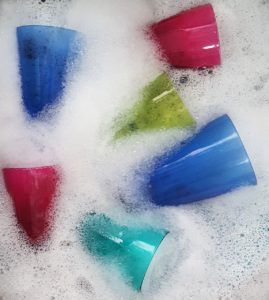
At times, your dishwasher may not clean the dishes properly. If you plan to repair the machine without the help of a dishwasher repairman, you should know which part could be responsible for the problem. Here is a brief guide to help you.
Discharge Housing Gasket
If the water pressure from the machine’s spray arm is low, the housing gasket of the upper discharge could be responsible for the problem. The gasket is usually located on the discharge cover just above the impeller. The housing gasket may have got dislocated or may need replacement. If the gasket is damaged and must be replaced, make sure you remove all the debris from the area before installing the new gasket.
Spray Arm
A problem with the machine’s lower spray arm could prevent the home appliance from cleaning the dishes properly. The spray arm is responsible for spraying strong stem of detergent and hot water on the dishes. Before you check the condition of the spray arm, make sure it is able to move freely and is not obstructed by the dirty dishes. At times, the bearing ring of the spray arm may be dislocated or worn out, which can cause the arm to wobble and prevent it spraying water and detergent evenly. If the bearing ring is not worn out or dislocated, you should visually inspect the spray arm for plugged holes or cracks. Food particles, glass, toothpicks, and other debris can clog the holes of the spray, which can impair the direction or force of the spray arm. If there are cracks on the spray arm, it will reduce water force and prevent the machine from cleaning the dishes properly.
Docking Station
Some dishwashers have a middle spray arm which is attached to the machine’s upper rack. In these machines, you must check the docking station and its flappers. The docking station, which has two outlets, provides water to the machine’s middle spray arm. Make sure the docking station is connected properly to the tube that supplies water to the machine. Also, make sure the flappers move freely and close securely to prevent pressure loss when the supply tube of middle spray arm is not inserted.
Chopper

Water Inlet Valve
A part of the dishwasher that is most likely to fail and prevent the machine from cleaning the dishes properly is the water inlet valve. The valve is located near the lower access panel which is usually in the front of the machine. If water level is not maintained or the machine does not have water, you must first inspect the valve to ensure that power is supplied to the valve when water enters the machine. You can check this using the multi-meter. If there is no problem with the power supply, the valve must be replaced.
Water Delivery Tube
In machines that have upper spray arm, a problem in water delivery tube can prevent the washer from cleaning the dishes properly. The tube is usually made of plastic and it is responsible for supplying water to the upper spray arm. When checking the condition of the tube, make sure it is properly aligned with spray arm and there are no obstructions.
Filters
Most dishwashers are equipped with at least one filter to remove debris from machine during the wash cycle. These filters come with a self-cleaning feature but under detergent use or certain water conditions, it can become clogged. The filter is usually a part of the pump or wash arm assembly. If you suspect that the filter is not doing its job, you should clean the filter. If cleaning does not help, you may have to replace the filter.
Wash Spinner
The wash spinner is a wash arm that is usually on the manifold or on the water feed tube. If the spinner is dislocated or cracked, it could prevent the machine from cleaning the dishes properly.
Detergent Dispenser

The detergent dispenser may not be working properly because the dispenser cup could be caked or clogged with the old detergent. To troubleshoot this problem, all you have to do is clean the cup. Also, make sure detergent is released by the detergent cup during the wash cycle.
Heating Element
For the washer to clean the dishes properly, a temperature of about 142 degrees Fahrenheit must be maintained. The heating element is used by the washer to maintain the temperature of water inside the machine. It is important to note that when you select the normal wash cycle, the heating element does not play any role in heating the water. So, when you select the normal cycle, make sure the water is hot enough to clean the dishes. Avoid using very hot water to clean the dishes, as it could damage the dishes. Before you start the wash cycle, run the hot water in the sink for 5 to 10 minutes. If the temperature of water drops during the cycle, the heating element could be the culprit. Since the heating element cannot be repaired, you may have to get a replacement.
Pump Impellers
The dishwasher has two impellers – the drain impeller and the wash impeller. These impellers are located inside the dishwasher. The wash impeller is responsible for circulating water inside the machine and pressurizes the water spray arm. The drain impeller is used to drain from the machine. To check the condition of the impellers, you can visually inspect them. If the fins or hub is damaged, you may have to replace it.
Check for the communities that we service in popular cities:
Houston, Las Vegas, Little Rock, Charleston SC, New Haven, Eugene, Tacoma, San Francisco CA, Phoenix, New York City, Portland, Middletown, Aurora, Jacksonville, Omaha, Everett, Boston, Tampa, Lakewood, Philadelphia, St. Louis, Cleveland, Pittsburgh, Reno City, Louisville, San Jose, Birmingham, Atlanta GA, Milwaukee, Oklahoma City, Allentown, Bowie, Sacramento , Baton Rouge, Jackson, Fort Worth, Kansas City, Colorado Springs, Billings, Salt Lake City, Raleigh, Albuquerque, Austin, Columbia, Provo, Baltimore, Nashville, Dallas, Denver, Seattle, Portland, Virginia Beach, Columbus, Detroit, Providence, Orlando, Miami, Olympia, Los Angeles CA, San Antonio TX, Manchester, Tucson AZ, Minneapolis, Newark, Richmond, Henderson, San Diego, Charlotte NC, Chicago, Silver Spring, Indianapolis, Tallahassee
The post How To Fix Dishwasher That Won’t Clean Properly appeared first on OnSite Appliance
Great tips! It’s essential to check all these components when your dishwasher isn’t cleaning properly. From the spray arm to the water inlet valve, every part plays a role in ensuring efficient washing. Regular dishwasher maintenance and cleaning can often solve many common issues without needing a full repair.
ReplyDelete